Guest blogger: Cherry Rae
I recently attended my first Game Developers Conference, which was as intense as everyone who went to GDC promised me. It was also a successful and positive experience for me! However, I encountered some physical accessibility barriers.
I have fierce impostor syndrome and didn’t think I would be half as busy as I ended up being, but I experienced much more of the conference than I thought I would. I was invited to attend as a speaker on a panel discussing the current state of accessibility in games and where we see it going in the future. They also afforded me the opportunity to give the final presentation of the day-long Games Accessibility Conference that runs on the Monday of GDC.
The moment I said yes, I tried to figure out how accessible things would be. Aside from travel being difficult, as an autistic wheelchair user with very limited energy, it’s important that I plan and know what to expect in a busy and intimidating environment.
I scoured the GDC website, and they had wonderful things to say about diversity and inclusion. There was a code of conduct, but something was missing – no mention of accessibility. Before I even had my flights booked, I emailed GDC to find out more about accessibility, but I received no reply. I tried reaching out to the organizers via their official Twitter account, both directly and indirectly, when they released images of their adorable pixel maps that didn’t show the location of elevators or accessible bathrooms.
I know from past events in the US, Europe, and Canada that I’d likely face the usual barriers; the most basic and often the least obvious is carpets. They’re nice to walk on for tired and sore knees and ankles. When I was still able to walk enough, I lived for those extra plush carpets and the small amount of relief they provided. However, as a manual wheelchair user with limited energy and strength, they are murder to my muscles and joints. There are carpets everywhere in the Moscone Centre and trying to get across them was an actual work out for me. For example, it would take a non-disabled person about a minute to get from the elevators to the coffee stand, but for me, it took a good 4 minutes and a lot of effort. There were polished concrete borders around the carpet that I could have used, but this is where they placed the trash/recycling and meeting tables.
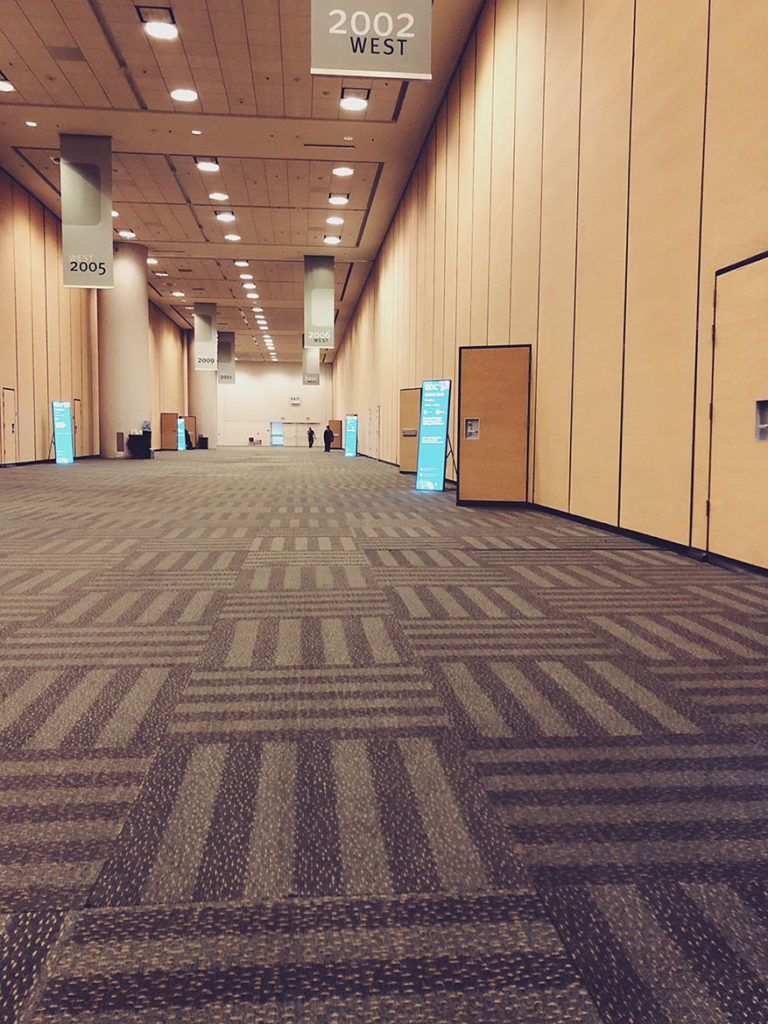
Being exhausted and in pain isn’t the best state to be in when listening to a presentation or arriving for my panel on Wednesday afternoon. Some days I had to forgo my morning coffee so I could get to a session on time. To be real, this was due partly to my poor understanding of the horrendous traffic in San Francisco; I didn’t leave enough time to traverse the great carpet plains.
I want to tell you how wonderful the Conference Associates were. These are the people that help the conference run, and they’re everywhere. They treated me with respect, and they knew how to ask if I needed help. They also took my word for it when I told them I was good. This was a huge boon to my experience at the conference. Despite the barriers I faced, they were a constant source of welcoming joy, and I can’t thank them enough.
The sessions themselves were incidentally not too bad for me because I use a small manual chair. However, there was never space for wheelchair users in the seating arrangement, so I often found myself in the aisle behind the Q&A mic. The aisles were wide, but in my chair, I took up half of the space. It was awkward for anyone that wanted to rush and line up. That was fun!
I did wait my turn to ask a question a couple of times. The Q&A mic was on a stand and not reachable. If I wanted to ask a question, I had to yell without a mic – not everyone is willing or able to do this, and it means most people in the room did not hear my questions. In one Microsoft session, I was offered a lapel mic, which was great, but it came from the presenters themselves. The only sessions I saw with an ESL interpreter or live captioning was the Ubisoft accessibility panel I was part of and a Microsoft-sponsored presentation. There may have been more, but I couldn’t visit all the events. None of the bigger sessions I attended had access for d/Deaf or HoH attendees.
So, let’s talk stage access. All the stages have a couple of steps and the usual tall podiums. Some had tables or space enough for speakers to talk without the podium. For my panel, the organizers had to make the stage wheelchair accessible. The venue provided us with a large wheelchair lift. It was overkill for the size of the stage, and I would always prefer a ramp.
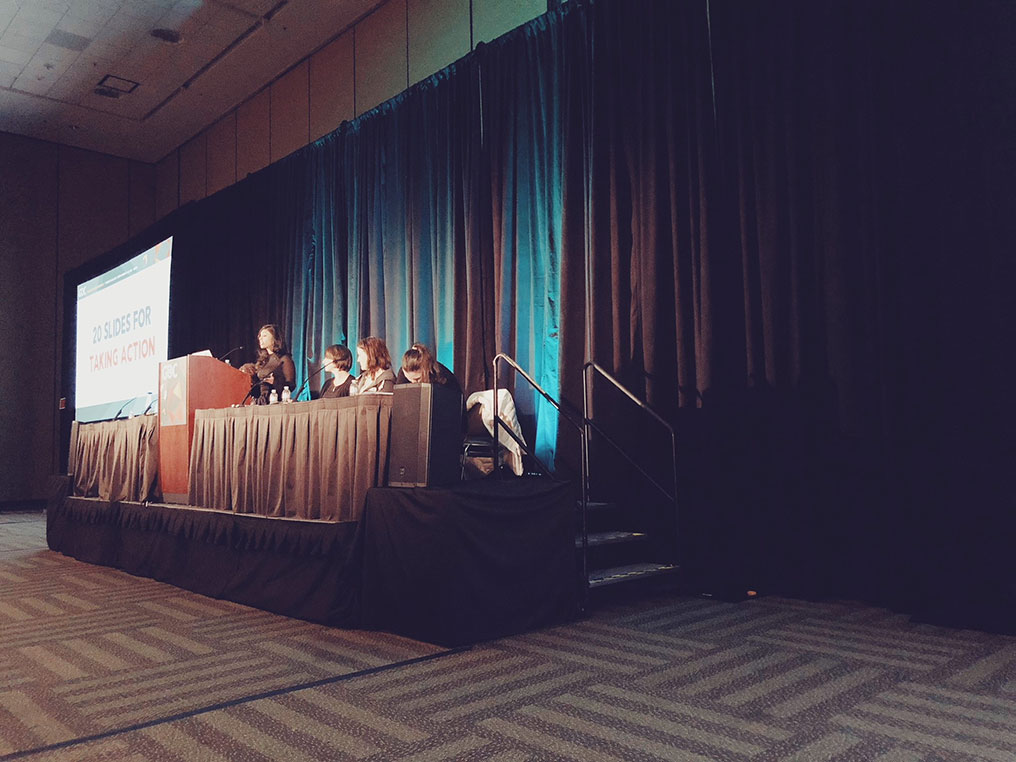
Of course, on this day, the lift was broken, and we didn’t find out until I arrived just moments before our session. The only way for me to get up on stage was to transfer out of my chair to the stage and have a Ubisoft producer lift my chair up for me to transfer back into. The stage was barely at the height of my chair – a giant lift was probably unnecessary. I was lucky that my impairments mean I even had a solution. Not all wheelchair users would have been able to transfer as I did. My chair is 23lbs and easy to lift by able-bodied people; a full powerchair is at least 110lbs, and impossible to lift by anyone – except maybe a Scottish Strongman, but who has one of those guys just hanging around?
I am a little bit proud that I managed to speak on stage. Due to being autistic, I don’t deal well with the unexpected, but perhaps the point is that this sadly isn’t too unexpected. Of course, I told everyone it was okay and made jokes about how normal an experience this is for me, but they kindly brought me back to reality and told me I shouldn’t have to experience this kind of thing. Props to the amazing people in the industry I found myself surrounded by. They were kind and helpful in the best possible way, and we made it work.
The access barriers on the Expo floor were another issue. I wrote on twitter about it shortly after the week was over, and it was passed onto the organizers. I’m hopeful that solutions will be in place next year. The biggest barrier was the height of the booths – nearly everything in the north hall (where the Indie developers were) was bar height, with tall chairs. This arrangement is a barrier to both wheelchair users and people who are not able to stand or sit at that height.
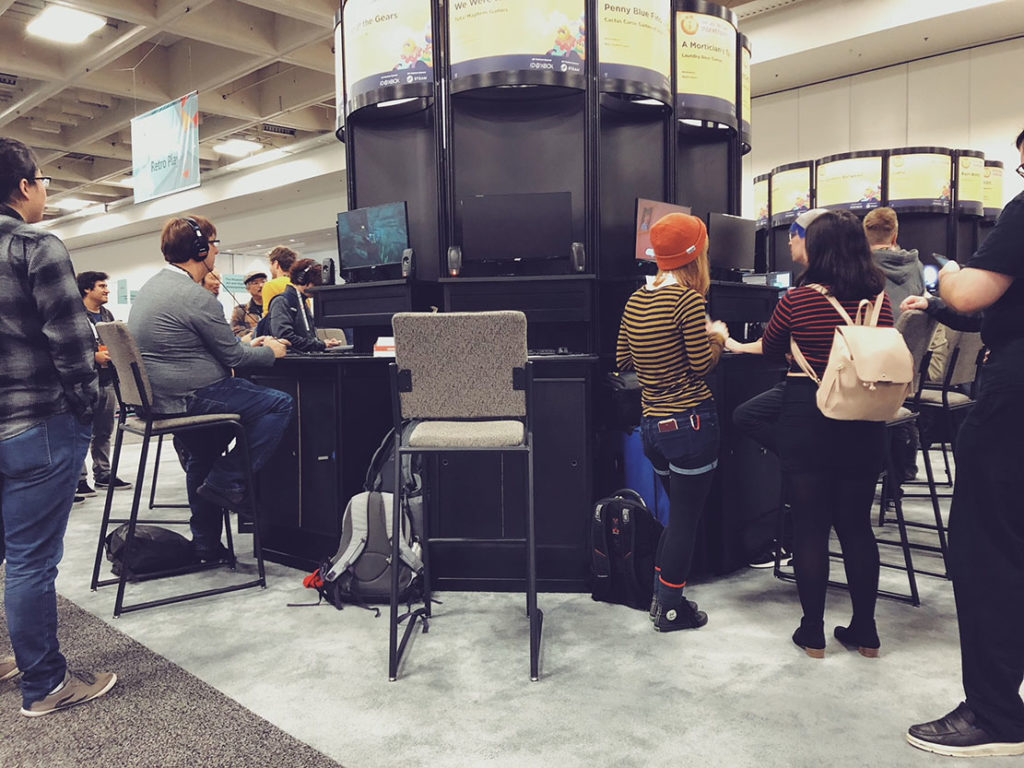
I came across a similar barrier at the ID@XBox booth earlier that week – the booth showcased many indie games at standing height on individual stations. After discussing it, they quickly had a solution with a desk-height table where any of the games could be played and discussed with the developer. They also told me, going forward, they would plan for more wheelchair access and space in their booths. This response is an excellent outcome, and I hope others see the work they do and follow suit.
Other well-known publishers and development companies had low stations with couches, bean bags and the like. While this isn’t particularly wheelchair friendly, with the right help, I could transfer or have someone move the furniture out of my way to hand me the controls for the showcased game. The difficulty with these types of booths is that everything is packed too tightly for me to get into it without help.
Only handful of indie developers had made sure to have a low station. The few that had accessible booths, I was informed, had brought their equipment, been very insistent, or paid extra.
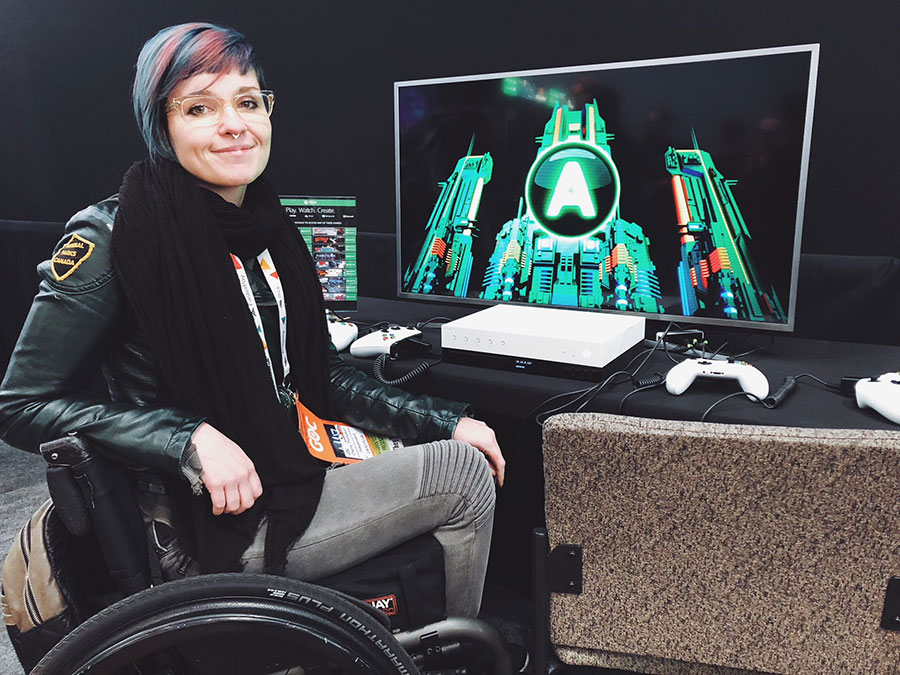
One last barrier I encountered is potentially dangerous. Like any big event, there were electrical wires routed along the floor throughout. They were simply under the carpet with barely visible tape marking their presence in select places. A few times, I didn’t see them and almost tipped out of my chair.
My GDC experience was overwhelmingly positive. I met so many passionate and interesting people who are working hard to bring accessibility, diversity, and inclusion to the forefront of gaming. I can’t speak highly enough of everyone I met. The response I received after the conference when I began discussing the access issues on Twitter has also been fantastic. The dialogue has made several developers and organizers vow to improve their contribution in the future. Despite the barriers I encountered, the biggest difference to my experience with GDC was their lack of defensiveness and willingness to listen to my experience. I’m very impressed and proud of the industry and how it addresses accessibility. There’s still some way to go, but there’s a lot of people working hard to make the industry truly inclusive.
My speaking engagements went well, and I received valuable feedback. Regardless of the physical barriers, the entire thing was a mental rejuvenation and made me more passionate about what I do as an advocate in the industry.
Cherry is an accessibility advocate, streamer, artist, a reluctant human and actual cyborg. They found community in games and a path to channel their purpose for life after their physical disabilities progressed to the point they could no longer work in their chosen field of the visual arts. You can find them most days on Twitter or Twitch.
Help us support our guest bloggers on Patreon!

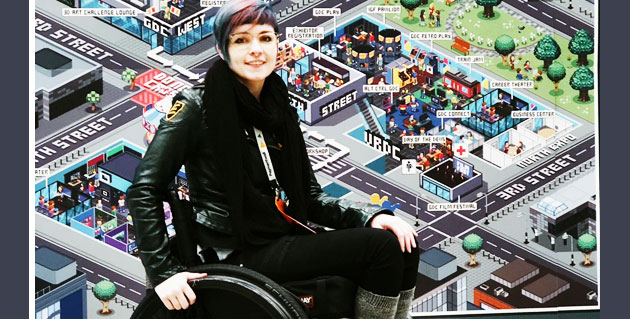
Glad you wrote this article! Hopefully they can correct some of these issues next year.